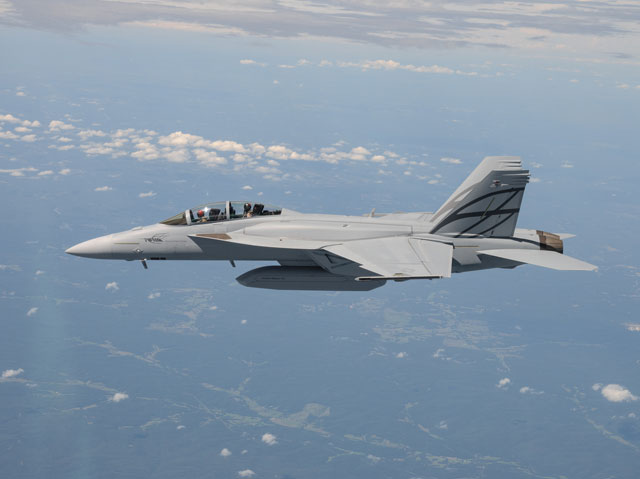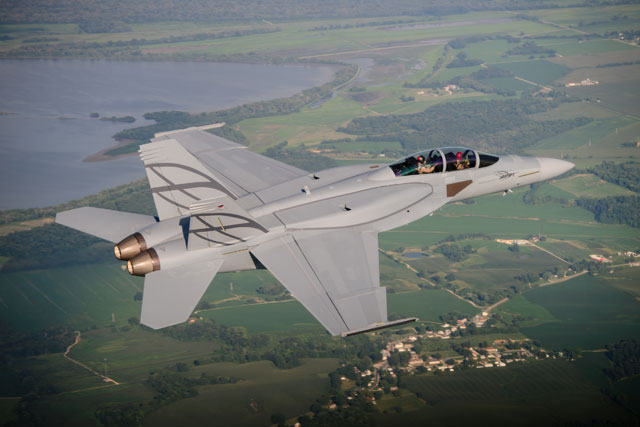Boeing has unveiled an F/A-18F Super Hornet demonstrator aircraft fitted with a number of enhancements designed to improve its stealth capability and range.
Shown at its factory in St Louis, Missouri, the modifications to the baseline aircraft include the addition of prototype conformal fuel tanks (CFT), an enclosed weapons pod and new radar cross-section treatments.
"It feels the same to the pilot," says Ricardo Traven, Boeing's chief test pilot for the type, describing the flight characteristics of the twin-engined strike fighter when equipped with the prototype 680kg (1,500lb) CFTs and 930kg weapons pod.
 |
|---|
Boeing |
That was one of the goals of the effort, says Paul Summers, Boeing's F/A-18E/F and EA-18G programme director. The CFTs produce no drag at subsonic cruise speeds up to Mach 0.84, he says. In fact, at M0.6, the CFTs actually produce less drag than a clean aircraft.
Drag does rise at supersonic speeds, says Mike Gibbons, Boeing's vice-president for the F/A-18 and EA-18G, but only to a level comparable with that of a single 1,817litre (480USgal) centerline drop tank.
The prototype tanks fitted to the test aircraft, which Boeing is leasing from the US Navy, are aerodynamically representative, but are non-functional. The production version will weigh 395kg and carry 1,588kg (3,500lb) of fuel, Summers says, boosting range by 260nm (481km).
Like the conformal tanks, the prototype weapons pod is also an aerodynamically representative shape, but is non-functional. Boeing has performed windtunnel tests with the pod's doors open up to speeds of M1.6, it says.
 |
|---|
Boeing |
An operational version of the weapons pod is expected to weigh roughly 408kg and hold 1,134kg of munitions. But despite its large payload, it will have roughly the same drag profile as a centerline drop tank, Summers says.
The modified Super Hornet boasts a 50% improvement in its low-observable signature. While not an all-aspect stealth aircraft, Gibbons says the enhancements will greatly improve the Super Hornet's already low frontal radar cross-section.
While it will not equate to a dedicated stealth fighter, it will be "good enough" for most of the navy's future missions in contested airspace, he says.
Summers says the prototype-equipped fighter has flown 15 flights, accumulating 25h. Nine additional flights are planned, which are anticipated to amass a further 14h.
Efforts are also under way to integrate an internal infrared search and track system on to the Super Hornet and to boost engine power on the jet's General Electric F414s by 20%.
The potential benefits of the Boeing-led efforts have not been lost on the navy. Earlier this year, Capt Frank Morley, the Naval Air Systems Command F/A-18 programme manager, told reporters that both his command and the Office of the Chief of Naval Operations are supporting the Boeing effort.
In fact, according to Boeing officials, the electronic warfare EA-18G might benefit more from the modifications than the regular Super Hornet.
Boeing estimates it could bring the modifications to market for a development cost of $1 billion by the end of the decade, if the service signs a contract relatively quickly.
Production aircraft would cost roughly 10% more than a current Block II Super Hornet.
Source: Flight International


























